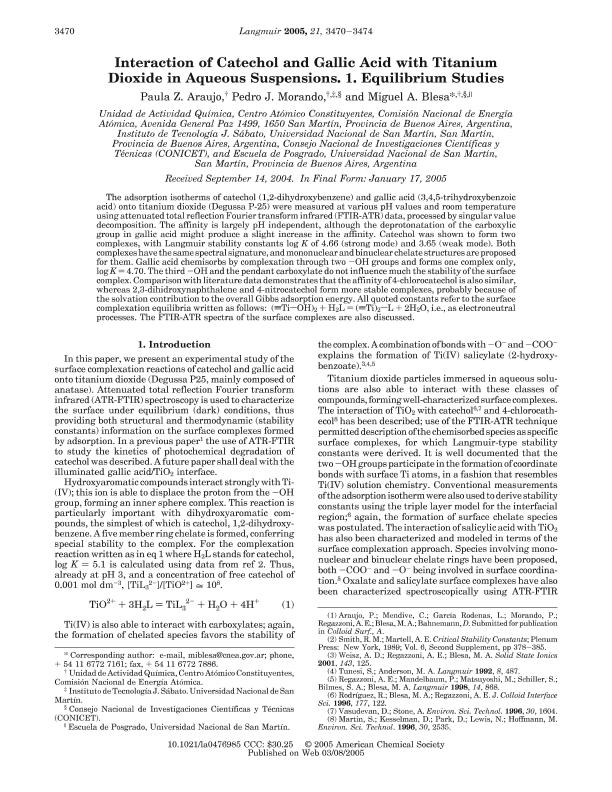Mostrar el registro sencillo del ítem
dc.contributor.author
Araujo, Paula Zulema

dc.contributor.author
Morando, Pedro Juan

dc.contributor.author
Blesa, Miguel Angel

dc.date.available
2018-08-14T20:01:10Z
dc.date.issued
2005-04
dc.identifier.citation
Araujo, Paula Zulema; Morando, Pedro Juan; Blesa, Miguel Angel; Interaction of catechol and gallic acid with titanium dioxide in aqueous suspensions. 1. Equilibrium studies; American Chemical Society; Langmuir; 21; 8; 4-2005; 3470-3474
dc.identifier.issn
0743-7463
dc.identifier.uri
http://hdl.handle.net/11336/55492
dc.description.abstract
The adsorption isotherms of catechol (1,2-dihydroxybenzene) and gallic acid (3,4,5-trihydroxybenzoic acid) onto titanium dioxide (Degussa P-25) were measured at various pH values and room temperature using attenuated total reflection Fourier transform infrared (FTIR-ATR) data, processed by singular value decomposition. The affinity is largely pH independent, although the deprotonatation of the carboxylic group in gallic acid might produce a slight increase in the affinity. Catechol was shown to form two complexes, with Langmuir stability constants log K of 4.66 (strong mode) and 3.65 (weak mode). Both complexes have the same spectral signature, and mononuclear and binuclear chelate structures are proposed for them. Gallic acid chemisorbs by complexation through two -OH groups and forms one complex only, log K= 4.70. The third -OH and the pendant carboxylate do not influence much the stability of the surface complex. Comparison with literature data demonstrates that the affinity of 4-chlorocatechol is also similar, whereas 2,3-dihidroxynaphthalene and 4-nitrocatechol form more stable complexes, probably because of the solvation contribution to the overall Gibbs adsorption energy. All quoted constants refer to the surface complexation equilibria written as follows: (≡Ti-OH) 2 + H2L = (≡Ti)2-L + 2H2O, i.e., as electroneutral processes. The FTIR-ATR spectra of the surface complexes are also discussed. © 2005 American Chemical Society.
dc.format
application/pdf
dc.language.iso
eng
dc.publisher
American Chemical Society

dc.rights
info:eu-repo/semantics/openAccess
dc.rights.uri
https://creativecommons.org/licenses/by-nc-sa/2.5/ar/
dc.subject
Catechol
dc.subject
Gallic Acid
dc.subject
Titanium Dioxide
dc.subject
Equilibrium
dc.subject.classification
Otras Ciencias Químicas

dc.subject.classification
Ciencias Químicas

dc.subject.classification
CIENCIAS NATURALES Y EXACTAS

dc.title
Interaction of catechol and gallic acid with titanium dioxide in aqueous suspensions. 1. Equilibrium studies
dc.type
info:eu-repo/semantics/article
dc.type
info:ar-repo/semantics/artículo
dc.type
info:eu-repo/semantics/publishedVersion
dc.date.updated
2018-08-13T18:15:55Z
dc.journal.volume
21
dc.journal.number
8
dc.journal.pagination
3470-3474
dc.journal.pais
Estados Unidos

dc.journal.ciudad
Washington
dc.description.fil
Fil: Araujo, Paula Zulema. Consejo Nacional de Investigaciones Científicas y Técnicas; Argentina. Comisión Nacional de Energía Atómica. Centro Atómico Constituyentes; Argentina
dc.description.fil
Fil: Morando, Pedro Juan. Consejo Nacional de Investigaciones Científicas y Técnicas; Argentina. Comisión Nacional de Energía Atómica. Centro Atómico Constituyentes; Argentina. Universidad Nacional de San Martín. Instituto Sabato; Argentina
dc.description.fil
Fil: Blesa, Miguel Angel. Consejo Nacional de Investigaciones Científicas y Técnicas; Argentina. Comisión Nacional de Energía Atómica. Centro Atómico Constituyentes; Argentina. Universidad Nacional de San Martín; Argentina
dc.journal.title
Langmuir

dc.relation.alternativeid
info:eu-repo/semantics/altIdentifier/doi/https://dx.doi.org/10.1021/la0476985
dc.relation.alternativeid
info:eu-repo/semantics/altIdentifier/url/https://pubs.acs.org/doi/abs/10.1021/la0476985
Archivos asociados
